Jeremy Mohler is a writer living in Washington, DC. After receiving a B.A. degree from the Philip Merrill Collegel of Journalism at the University of Maryland, he has self-published essays and poems at www.jeremymohler.org. His essay on Swiss artist Alberto Giacometti is forthcoming in the next issue of The Johns Hopkins University literary journal The Doctor T.J. Eckleburg Review. Today we share his recent essay titled, An Illusion of Division.
__
An Illusion of Division
Photography is far too expansive and elusive of a concept and practice to talk about in dogmatic language. It is known most collectively as art; but it’s safe to say that a majority of photographers are simply, in their eyes, documenting experience, and communicating that experience in the bright complicated ball of protean stimulus that is the contemporary culture. Because when words fail us - as they often do - photos are for obvious reasons the more precise, “authentic” method of reaching each other. I quote the word because that a photograph can be authentic is pretty complicated, and amputated from the actual practice of snapping a photo, pretty irrelevant. But I think I know what people mean when they say a photo is an “authentic” documentation of the world at a particular time and in a particular place. When taking a photo there is a sense that one is standing somewhere outside of the cage of subjectivity and peering into the cage of objectivity. One feels as though she can escape self, because, outside of a self-portrait (which, self-consciously named as such, is another way to escape the container of self), the picture taker cannot be in the photo, so, the photo is inherently recording the-world-minus-the-self. This is a default sense when looking through a lens and it’s hard to avoid. With this mentality, actuality is a zoo and the photographer is a tourist.
Though, contemporary photography (and pop culture as a whole) has attempted to move outside these theoretical bounds. Today’s photography is often described by calling it contemporary, which, of course, is tautological, and tautological theories are how movements of the present are labeled until a large enough paradigm shifts the field and makes us wonder why we didn't see that everything contemporary had a homogenous style, method, or defining trait that can be reduced and subjugated, and so, tamed. And then, of course, when a style is classified and labeled, with all the life sucked out of the practice, artists have a clear sense of how to violate the new norms and an anti-school is created. But, to many an artist’s confusion, this ping pong has broken down into a big untidy mess in what some refer to as postmodernism, which blatantly is a catch all word to gather up anything after modernism, and is a very loaded term. So, how can we get a handle on the art form?
Here’s my attempt: a flock of conceptual art methods currently circles the decomposing body of conventional photography. Abrasive computer manipulation (I’m not talking about touchups) works on the same illusion that conventional photography does, that what is in the frame is supposed to be actuality, because the trick in a “Photoshopped” image is that the eye sees the manipulation and hesitates about its realness. The whole thing works because the average viewer is expecting a photo to be of something real. Both “Photoshopped” work and manipulation of prints (cutouts, drawing on the photo, etc.) display a self-consciousness about the work being a piece of art and the photographer being an artist that is utterly postmodern. It gets ironic and recursive fast. A photographer wishing to avoid manipulation is left with either an attempt at “objective” photojournalism, or the double entendre of taking a photo with an affectation that says, I know that you know that I’m a photographer so I’m going to mock myself doing it. There seems to be no pure, “authentic” place to run to, now, as a photographer.
So, then, maybe it’s about the viewer? Where do most people look at photography: In a gallery? On an iPad screen? On someone’s blog? And what do they even see? In a democratizing world mired by a late, distorted capitalism, these questions are harder than ever to answer with any authority. A computer screen shares an essential feature with the photograph: it is not the computer screen we see, but what is in it, just as we do not see a photograph but what it is a photograph of. I wonder what it felt like the first time I saw an actual print: did I see the print in my mother's hand, or did I fall for the illusion and see my uncle sitting on the couch holding me, as depicted in the photo? And photographs online are even more souvenirs of reality than actual prints are; there is nothing even tangible about them, they “exist” on a screen and come and go with a click.
Some more substantial questions, I think, must then be answered, since I can’t seem to make words out of the direction photography is headed. How do we communicate with each other, trust each other, believe in each other, when we've been taught from a young age not to trust authority for the sake of it being authority? And how do we communicate with each other deeply when nearly everyone is always taking a picture? A near ubiquity of image in pop culture makes it tough to look at photos with any trace of openness. It also renders what is photographed and experience itself as convenient, disposable, and worse, logical. With infinite and free access to images online, the seduction of parataxis (juxtaposition between words or images) melts into a flattened plane of relative image. It takes work to disconnect and look at a book of photography, or go see a thoughtfully curated show.
This may all sound conceptual and jargony, but it’s true, for me. I need space from visual stimulus to see more in a photo and to appreciate the art of photography. Parts of my brain become lazy in the daily onslaught of image. After a detox from the visual, I look at a photo and can cherish the self-consciousness of the photographer; I appreciate that they realize (consciously or not) that they are mediating the image and thus can do whatever they want with it. It seems that from these observations that I can say with little doubt that the near ubiquity of image in our current culture makes it harder to not look at a photograph with cynicism AND not take a photo with an ironic affectation. The most important point of art, to me, is to remind us that the act of asking a question is the answer. Actuality is not supposed to be in a photograph, it is here (there) and now (then).
Jeremy Mohler
__
To view more writings and poetry or to read more information about Jeremy please visit his website.
![]()
![]() My recent work deals with my fear of failing as a father, and attempts to make something of the successful moments. I use photography to engage my daughter. Together we construct images; she leads at times and at others I beg her to stay still. She has become the impetus, a character, and the audience. I set out to make a fable, but reality has leaked its way into the myth.
My recent work deals with my fear of failing as a father, and attempts to make something of the successful moments. I use photography to engage my daughter. Together we construct images; she leads at times and at others I beg her to stay still. She has become the impetus, a character, and the audience. I set out to make a fable, but reality has leaked its way into the myth.
![]()
![]()
![]() I shoot an 8x10" view camera. I use a formal, slowed down, format to give me a stage with which to play out ideas. At times they're spontaneous, and at times they are a collaboration with my four year old or my partner. Several of the images use multiple exposures, made in camera and I process film and print in a silver darkroom. I'm interested in renegotiating the line that we draw between is and if, and my work exists in the occasionally magical, often mundane, landscape of play.
I shoot an 8x10" view camera. I use a formal, slowed down, format to give me a stage with which to play out ideas. At times they're spontaneous, and at times they are a collaboration with my four year old or my partner. Several of the images use multiple exposures, made in camera and I process film and print in a silver darkroom. I'm interested in renegotiating the line that we draw between is and if, and my work exists in the occasionally magical, often mundane, landscape of play.
![]()
![]()
![]()
![]()
![]()
![]()
![]()
![]()
![]() To view more of Scott's work please visit his website.
To view more of Scott's work please visit his website.

 My recent work deals with my fear of failing as a father, and attempts to make something of the successful moments. I use photography to engage my daughter. Together we construct images; she leads at times and at others I beg her to stay still. She has become the impetus, a character, and the audience. I set out to make a fable, but reality has leaked its way into the myth.
My recent work deals with my fear of failing as a father, and attempts to make something of the successful moments. I use photography to engage my daughter. Together we construct images; she leads at times and at others I beg her to stay still. She has become the impetus, a character, and the audience. I set out to make a fable, but reality has leaked its way into the myth.


 I shoot an 8x10" view camera. I use a formal, slowed down, format to give me a stage with which to play out ideas. At times they're spontaneous, and at times they are a collaboration with my four year old or my partner. Several of the images use multiple exposures, made in camera and I process film and print in a silver darkroom. I'm interested in renegotiating the line that we draw between is and if, and my work exists in the occasionally magical, often mundane, landscape of play.
I shoot an 8x10" view camera. I use a formal, slowed down, format to give me a stage with which to play out ideas. At times they're spontaneous, and at times they are a collaboration with my four year old or my partner. Several of the images use multiple exposures, made in camera and I process film and print in a silver darkroom. I'm interested in renegotiating the line that we draw between is and if, and my work exists in the occasionally magical, often mundane, landscape of play.







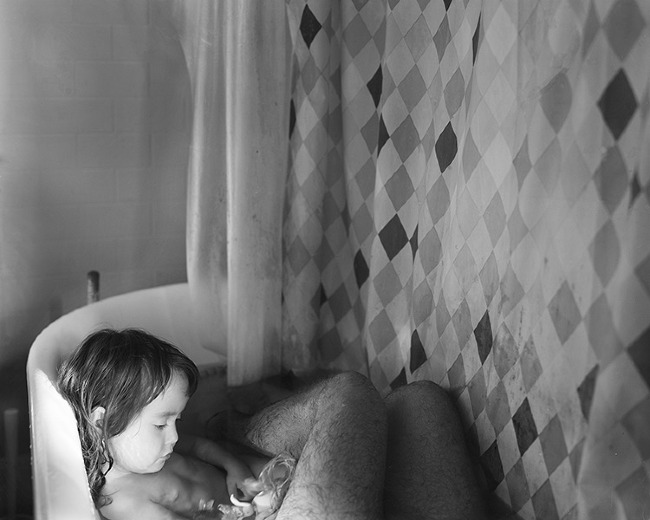
 To view more of Scott's work please visit his website.
To view more of Scott's work please visit his website.
 Introduction by
The Editors
Essays by
Joel Kuennen
Featured Artists
Clayton Cotterell, Daniel Gordon, Trey Wright, Andrew B. Myers, Anthony Gerace, Stefan Vorbeck/ Stillsandstrokes.
From the Editors
“Escapism: the tendency to seek distraction and relief from unpleasant realities, especially by seeking entertainment or engaging in fantasy.”
As editors and photographers, we become fatigued by images that demand we feel a certain way, seek an obscured message, or focus intensely— our weary eyes find respite in off-white, lightly textured plaster walls.
The images in this issue are most easily described as fun. As a viewer, we are not asked to believe anything. We are free to unload our own thoughts or fantasies into these spaces. We take away what we want, if we want. That’s not to say that these images were created devoid of all meaning. Inside, Joel Kuennen presents insightful connections to the Dada movement.
Is it wrong to simply enjoy the surface? Does ignorance provide true relief?
__
8.25"x11", 64 pages, Perfect Bound
Printed In Hong Kong.
Edition Size 500
Order at our Shop →
Introduction by
The Editors
Essays by
Joel Kuennen
Featured Artists
Clayton Cotterell, Daniel Gordon, Trey Wright, Andrew B. Myers, Anthony Gerace, Stefan Vorbeck/ Stillsandstrokes.
From the Editors
“Escapism: the tendency to seek distraction and relief from unpleasant realities, especially by seeking entertainment or engaging in fantasy.”
As editors and photographers, we become fatigued by images that demand we feel a certain way, seek an obscured message, or focus intensely— our weary eyes find respite in off-white, lightly textured plaster walls.
The images in this issue are most easily described as fun. As a viewer, we are not asked to believe anything. We are free to unload our own thoughts or fantasies into these spaces. We take away what we want, if we want. That’s not to say that these images were created devoid of all meaning. Inside, Joel Kuennen presents insightful connections to the Dada movement.
Is it wrong to simply enjoy the surface? Does ignorance provide true relief?
__
8.25"x11", 64 pages, Perfect Bound
Printed In Hong Kong.
Edition Size 500
Order at our Shop →
 Alex Parrish: What got you into photography?
Anthony Smith: I think the first time I saw photography as really something I wanted to get into was seeing 'Mothlight' by Stan Brackhage in college. I had a professor, Jim Herbert, who studied under him and had an actual 16mm print of the film. I thought at the time I'd be a graphic designer or something. Anyways, he actually glues down individual moth wings down to the film reel. It was better than anything I'd ever seen before. We were making these super 8 films and I couldn't really get into the idea of the narrative or duration of film, but I loved the immediacy of the light through the film and the illusion of it all.
Your past work has an invariable element of urban southern gothic. Are you from the South?
Haha, well I moved to the South from the Midwest when I was young, to a small town outside of Atlanta during the whole suburban boom of the 90's. It was a total culture shock for me. I was from an all Catholic family, I had never seen a mega church or anything like that, so yeah I could really relate to authors like Flannery O'Connor in a lot of ways.
Your work in progress takes a liberal move towards the conceptual. What inspired your new work?
I think the new work grew out of the old work in a way. While I was working on the images for In Dog Years I was renting this cheap old shotgun house in Cabbagetown and I collected these found photos from the crawl space, of all the previous kids who had rented the house before us, and began to mix them in with my own work. I liked the idea of creating my own mythology about the young people who lived there before and how I could relate that to the pictures I was making. At the same time, I was working at a print shop that does commercial art and photography for hotels and restaurants. So I might print a thousand prints of a painting one day, or Photoshop the color in something to match the carpet in a room, and so much of it becomes trivial and overwhelming. Seeing so much of it everyday started to influence how I thought about art-making and sort of the little codes that exist within how we look at things, and the utility of it all, and I guess the narrative in my work started to slip away.
Alex Parrish: What got you into photography?
Anthony Smith: I think the first time I saw photography as really something I wanted to get into was seeing 'Mothlight' by Stan Brackhage in college. I had a professor, Jim Herbert, who studied under him and had an actual 16mm print of the film. I thought at the time I'd be a graphic designer or something. Anyways, he actually glues down individual moth wings down to the film reel. It was better than anything I'd ever seen before. We were making these super 8 films and I couldn't really get into the idea of the narrative or duration of film, but I loved the immediacy of the light through the film and the illusion of it all.
Your past work has an invariable element of urban southern gothic. Are you from the South?
Haha, well I moved to the South from the Midwest when I was young, to a small town outside of Atlanta during the whole suburban boom of the 90's. It was a total culture shock for me. I was from an all Catholic family, I had never seen a mega church or anything like that, so yeah I could really relate to authors like Flannery O'Connor in a lot of ways.
Your work in progress takes a liberal move towards the conceptual. What inspired your new work?
I think the new work grew out of the old work in a way. While I was working on the images for In Dog Years I was renting this cheap old shotgun house in Cabbagetown and I collected these found photos from the crawl space, of all the previous kids who had rented the house before us, and began to mix them in with my own work. I liked the idea of creating my own mythology about the young people who lived there before and how I could relate that to the pictures I was making. At the same time, I was working at a print shop that does commercial art and photography for hotels and restaurants. So I might print a thousand prints of a painting one day, or Photoshop the color in something to match the carpet in a room, and so much of it becomes trivial and overwhelming. Seeing so much of it everyday started to influence how I thought about art-making and sort of the little codes that exist within how we look at things, and the utility of it all, and I guess the narrative in my work started to slip away.


 How do you create each image?
I'm usually inspired by something I've found, that I want to see photographed, or I'll see the same type of photo enough times that I want to try to re-interpret it in my own way. Like the image of the cemetery attached to the concrete wall, I had been seeing tons of black and white architectural pictures everywhere, really stark and serious you know. So I found a travel photo I had taken at Pere Lachaise cemetery last year and printed it out on adhesive vinyl and attached it to a cinder block wall. To me it takes the seriousness and beauty of the image away, I mean you know its a flat picture now, and its attached to the absolute least decorative of architectural materials.
Your work in progress seems to combine object, color, lighting and composition in an effort to create a jarring context. Are those your intentions?
Yeah, you know I see ads now everywhere I go, and sometimes its so painful to look at them because the context is so obvious, even though they try to hide it from you. I'm more inclined to hope my photographs are like a picture from a Craigslist ad where someone's trying to sell an old filing cabinet or something, I mean both images are getting at the same thing, they want to sell you something but one is less deceptive.
Several images within your work in progress, specifically “Paper Pile Up,” have a three dimensional quality. How do you achieve this effect?
For that image I piled up sheets of paper up the back of a seamless backdrop, I wanted to kind of reveal it in the picture. Usually you know the seamless is hidden, to draw your attention to whatever the subject is. Then, I dissect the image into separate CMYK 'plates' and print each plate individually and flip them and mix them up until I get something interesting.
When will these works in progress find completion? Do you anticipate creating a large body of work out of it?
I hope so, for now it's fun to be playing and experimenting, maybe one day I'll feel like everything is cohesive enough to make a little zine or something.
How do you create each image?
I'm usually inspired by something I've found, that I want to see photographed, or I'll see the same type of photo enough times that I want to try to re-interpret it in my own way. Like the image of the cemetery attached to the concrete wall, I had been seeing tons of black and white architectural pictures everywhere, really stark and serious you know. So I found a travel photo I had taken at Pere Lachaise cemetery last year and printed it out on adhesive vinyl and attached it to a cinder block wall. To me it takes the seriousness and beauty of the image away, I mean you know its a flat picture now, and its attached to the absolute least decorative of architectural materials.
Your work in progress seems to combine object, color, lighting and composition in an effort to create a jarring context. Are those your intentions?
Yeah, you know I see ads now everywhere I go, and sometimes its so painful to look at them because the context is so obvious, even though they try to hide it from you. I'm more inclined to hope my photographs are like a picture from a Craigslist ad where someone's trying to sell an old filing cabinet or something, I mean both images are getting at the same thing, they want to sell you something but one is less deceptive.
Several images within your work in progress, specifically “Paper Pile Up,” have a three dimensional quality. How do you achieve this effect?
For that image I piled up sheets of paper up the back of a seamless backdrop, I wanted to kind of reveal it in the picture. Usually you know the seamless is hidden, to draw your attention to whatever the subject is. Then, I dissect the image into separate CMYK 'plates' and print each plate individually and flip them and mix them up until I get something interesting.
When will these works in progress find completion? Do you anticipate creating a large body of work out of it?
I hope so, for now it's fun to be playing and experimenting, maybe one day I'll feel like everything is cohesive enough to make a little zine or something.


 What would you cite as a major influence in your work as a whole?
I'm really influenced by films and movies right now, I have really been into 'TV Carnage' and 'Everything is Terrible'. These guys take clips from all sorts of weird and ordinary places and edit them together in a mind numbing way, but its really smart and funny. The last one I saw was a remake of 'The Holy Mountain' with all appropriated footage of dogs.
You recently gave a lecture at Auburn University. Could you tell us more about what you discussed?
I actually am giving this talk later this week, I have a show there with the work from In Dog Years up, so I'll talk mostly about that. It should be really exciting, I really want to see how people react to the exhibit. (Gallery Talk January 24//link for more information)
What do you think you’ll do next?
Well I'm hoping to go to grad school next fall, I just finished up all my applications, so keep your fingers crossed for me!
What would you cite as a major influence in your work as a whole?
I'm really influenced by films and movies right now, I have really been into 'TV Carnage' and 'Everything is Terrible'. These guys take clips from all sorts of weird and ordinary places and edit them together in a mind numbing way, but its really smart and funny. The last one I saw was a remake of 'The Holy Mountain' with all appropriated footage of dogs.
You recently gave a lecture at Auburn University. Could you tell us more about what you discussed?
I actually am giving this talk later this week, I have a show there with the work from In Dog Years up, so I'll talk mostly about that. It should be really exciting, I really want to see how people react to the exhibit. (Gallery Talk January 24//link for more information)
What do you think you’ll do next?
Well I'm hoping to go to grad school next fall, I just finished up all my applications, so keep your fingers crossed for me!

 Anthony Smith is a photographer living and working in Atlanta, GA. He holds a BFA from the
University of Georgia. His work can currently be seen at Eponymy gallery in Brooklyn and
Auburn University at Montgomery.
Alexandra Parrish lives and works in Atlanta, GA. She is involved in the Atlanta arts and music scene, but she is most proud of her pizza vixen status. Her writing has been published in Brooklyn Street Art and featured in Huffington Post.
Anthony Smith is a photographer living and working in Atlanta, GA. He holds a BFA from the
University of Georgia. His work can currently be seen at Eponymy gallery in Brooklyn and
Auburn University at Montgomery.
Alexandra Parrish lives and works in Atlanta, GA. She is involved in the Atlanta arts and music scene, but she is most proud of her pizza vixen status. Her writing has been published in Brooklyn Street Art and featured in Huffington Post.
 AUTO FIRE is a cycle of Paweł's photographs that treat – among others – about uncertainty,
indecisiveness, ones habits, ones anger. Its universal protagonist is someone about 30 years old and
at this point he looks back at his life.
The title AUTO FIRE brings the need of defining ones private emotions and feelings (or,
sometimes, lack of those). This symbolic 30s’ birthday is defined as a moment when one takes the
opportunity to reconstruct heretofore life’s episodes into the most secure and safe for its own psyche
form of narrative.
AUTO FIRE is a cycle of Paweł's photographs that treat – among others – about uncertainty,
indecisiveness, ones habits, ones anger. Its universal protagonist is someone about 30 years old and
at this point he looks back at his life.
The title AUTO FIRE brings the need of defining ones private emotions and feelings (or,
sometimes, lack of those). This symbolic 30s’ birthday is defined as a moment when one takes the
opportunity to reconstruct heretofore life’s episodes into the most secure and safe for its own psyche
form of narrative.

 The state of ‘in-between’ is the strongest linkage between the characters in the photos. Many
oppositions demand a final resolution. Paweł correctly picks up everyday absurdity. He takes out
its context of routine and shows it in form of an action snapshot that is, at the same time, both
documental and abstract.
The protagonists of the photos are suspended-like, since they are accompanied by an accumulated
tension at an edge of blowing up in a second. Impression of a recently captured snapshot is heighten
by its filmographic scenography. But will it twitch, will something happen? Isn’t it that it has
already happened and now we’re just left here to analyse and understand it?
Magda Garncarek
The state of ‘in-between’ is the strongest linkage between the characters in the photos. Many
oppositions demand a final resolution. Paweł correctly picks up everyday absurdity. He takes out
its context of routine and shows it in form of an action snapshot that is, at the same time, both
documental and abstract.
The protagonists of the photos are suspended-like, since they are accompanied by an accumulated
tension at an edge of blowing up in a second. Impression of a recently captured snapshot is heighten
by its filmographic scenography. But will it twitch, will something happen? Isn’t it that it has
already happened and now we’re just left here to analyse and understand it?
Magda Garncarek


 View more of this work, including commercial works on his website.
View more of this work, including commercial works on his website.
 RECENT WORK 2012
My work inhabits a space between photography, sculpture, architecture, installation and new media.
I construct installations with simple materials in the studio and project computer-generated shapes on to them, transforming the construction with light and shadows. In this way, I attempt to reconstruct mental spaces from my imagination, combining the contained physical world and the expansive possibilities of the virtual world to construct images.
Ideas of drawing and construction permeate through my work as I question notions of reality and perception. I am interested in the idea of the virtual becoming part of the real through the process of photographing digital projections and printing light. The final aesthetic result is a complex visual space that evokes a world that is both virtual and real.
RECENT WORK 2012
My work inhabits a space between photography, sculpture, architecture, installation and new media.
I construct installations with simple materials in the studio and project computer-generated shapes on to them, transforming the construction with light and shadows. In this way, I attempt to reconstruct mental spaces from my imagination, combining the contained physical world and the expansive possibilities of the virtual world to construct images.
Ideas of drawing and construction permeate through my work as I question notions of reality and perception. I am interested in the idea of the virtual becoming part of the real through the process of photographing digital projections and printing light. The final aesthetic result is a complex visual space that evokes a world that is both virtual and real.













 View more of her work on her website.
View more of her work on her website.
 Façade 1, 2011
Architects build on history, using the past to predict the future’s projected needs. Tokyo’s Nakagin Capsule Tower, designed by Kisho Kurokawa in 1972, exemplifies an architectural dream of the future that never materialized. Built as part of the Metabolism architecture movement, the Tower was meant to be an innovation in modular living that would allow businessmen to live close to their site of work in small but replaceable units.
Façade 1, 2011
Architects build on history, using the past to predict the future’s projected needs. Tokyo’s Nakagin Capsule Tower, designed by Kisho Kurokawa in 1972, exemplifies an architectural dream of the future that never materialized. Built as part of the Metabolism architecture movement, the Tower was meant to be an innovation in modular living that would allow businessmen to live close to their site of work in small but replaceable units.
 B1004 (Window), 2011
B1004 (Window), 2011 B807, 2012
The capsule design is drawn from the camera: just as a camera-obscura is a darkened room that allows light to enter an inscribe itself on the interior, the windows of the capsules allow light to pass through the spaces over time, recording itself by yellowing a once-futuristic vision. Fan-like shades once covered the large, round windows and recalled the leaf-shutter. Impractical, most are now removed, as are dated televisions and air conditioners. These details reveal the degree to which the capsules are now outmoded. Having exceeded their projected twenty-five year life-span, the design proves to be too rigid for replacement and renewal.
B807, 2012
The capsule design is drawn from the camera: just as a camera-obscura is a darkened room that allows light to enter an inscribe itself on the interior, the windows of the capsules allow light to pass through the spaces over time, recording itself by yellowing a once-futuristic vision. Fan-like shades once covered the large, round windows and recalled the leaf-shutter. Impractical, most are now removed, as are dated televisions and air conditioners. These details reveal the degree to which the capsules are now outmoded. Having exceeded their projected twenty-five year life-span, the design proves to be too rigid for replacement and renewal.
 A1007 (Wall II), 2011
A1007 (Wall II), 2011 B1004 (Wall), 2011
B1004 (Wall), 2011 A1203, 2012
While the building awaits an uncertain fate, Noritaka Minami documents it with his large format camera. This tool provides a static, scientific and academic experience of looking and analyzing. Coupled with careful framing, the photographs minimize the appearance of the artist and reveal thoughtful combinations of images that function as a document of this structure. The sites of the photographs are humanized by the contents of their inhabitants and become places for the intersection of past and present visions.
A1203, 2012
While the building awaits an uncertain fate, Noritaka Minami documents it with his large format camera. This tool provides a static, scientific and academic experience of looking and analyzing. Coupled with careful framing, the photographs minimize the appearance of the artist and reveal thoughtful combinations of images that function as a document of this structure. The sites of the photographs are humanized by the contents of their inhabitants and become places for the intersection of past and present visions.
 A706 (Wall II), 2011
A706 (Wall II), 2011 A706 (Wall I), 2011
A706 (Wall I), 2011 Corridor I, 2011
For more information, please visit Noritaka’s website.
Sarah is an artist and writer living and working in Boston, MA. She is a current MFA candidate at the School of the Museum of Fine Arts, Boston and Tufts University with an emphasis on photographic history and theory. She is the founder and curator of 3200K, a printed fine-art quarterly dedicated to emerging photographers working in analog media. Her photographs have been shown, published and included in corporate and private collections across the United States.
Corridor I, 2011
For more information, please visit Noritaka’s website.
Sarah is an artist and writer living and working in Boston, MA. She is a current MFA candidate at the School of the Museum of Fine Arts, Boston and Tufts University with an emphasis on photographic history and theory. She is the founder and curator of 3200K, a printed fine-art quarterly dedicated to emerging photographers working in analog media. Her photographs have been shown, published and included in corporate and private collections across the United States.
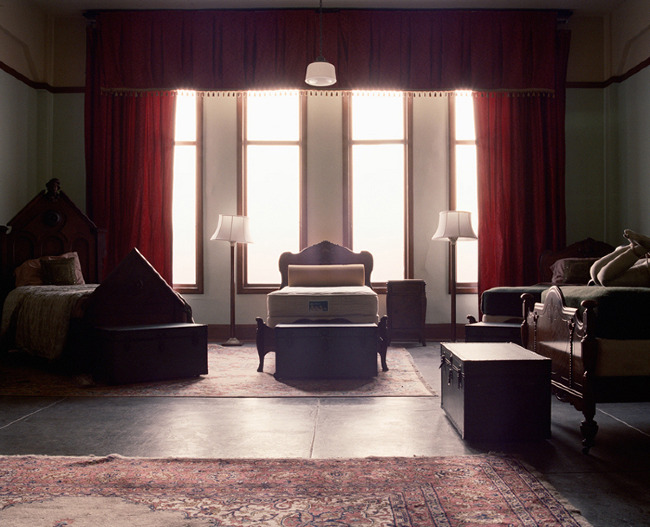
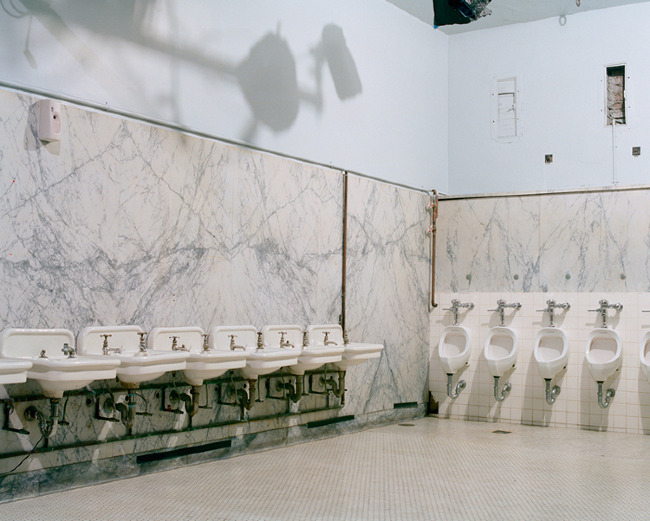
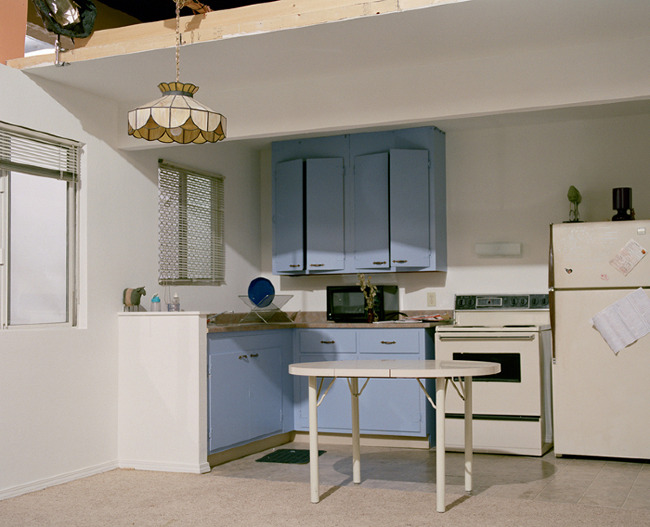 The Armory
2011–2013 (ongoing)
As is well known, fantasy and desire are often the result of mass manufacturing. Studies illustrate the changing sexual trends in America due to the increase in pornography consumption via the internet. However, what is produced is a direct result of what is demanded. What is watched is recreated and repackaged as something new. Does pornography, then, act as a mirror, a simple reflection of our collective, illicit desires?
The Armory
2011–2013 (ongoing)
As is well known, fantasy and desire are often the result of mass manufacturing. Studies illustrate the changing sexual trends in America due to the increase in pornography consumption via the internet. However, what is produced is a direct result of what is demanded. What is watched is recreated and repackaged as something new. Does pornography, then, act as a mirror, a simple reflection of our collective, illicit desires?
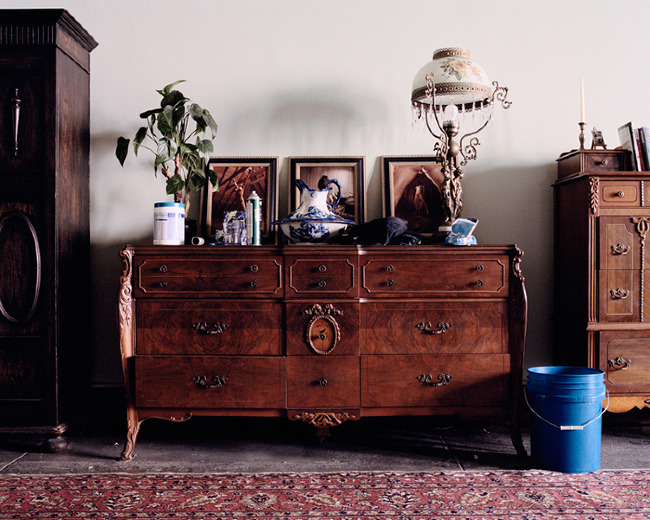
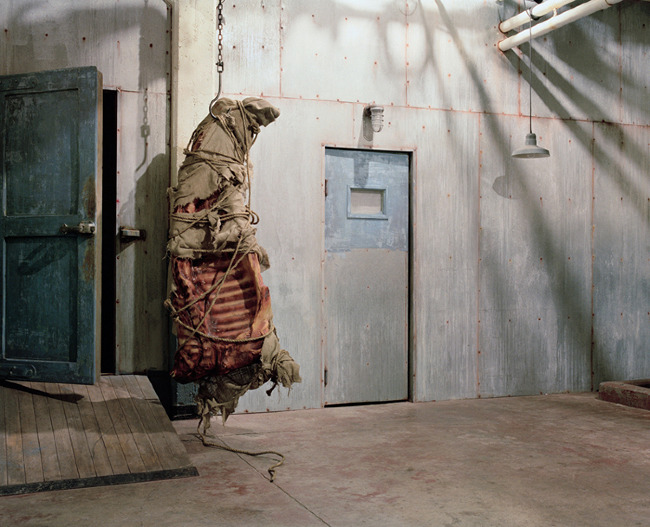 The Armory documents the ever-changing sets of the BDSM pornography company Kink.com. These custom-built backdrops, from suburban homes to meat lockers, appear both familiar and strangely foreign. Private spaces constructed daily for the public gaze indicate the demand, consumption, and manufacture of sexual fantasy.
The Armory documents the ever-changing sets of the BDSM pornography company Kink.com. These custom-built backdrops, from suburban homes to meat lockers, appear both familiar and strangely foreign. Private spaces constructed daily for the public gaze indicate the demand, consumption, and manufacture of sexual fantasy.
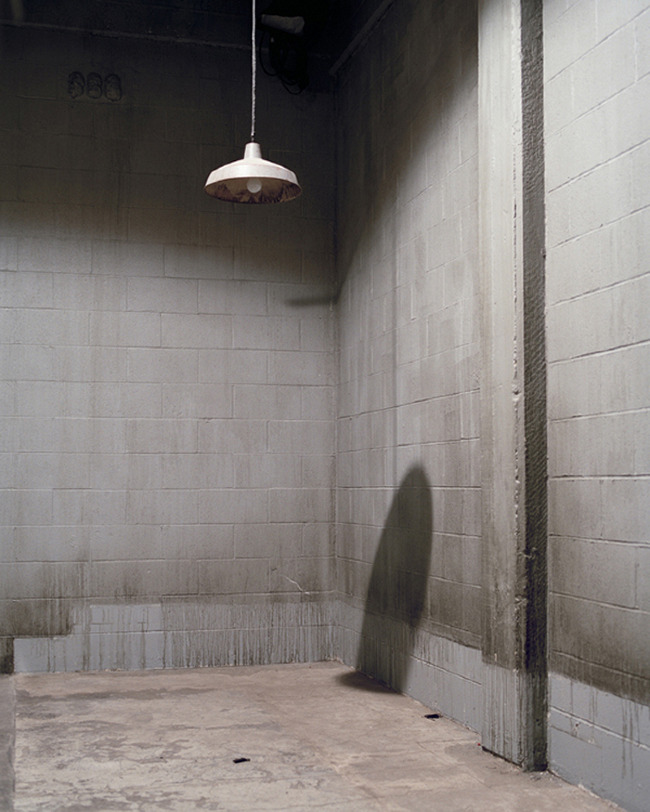
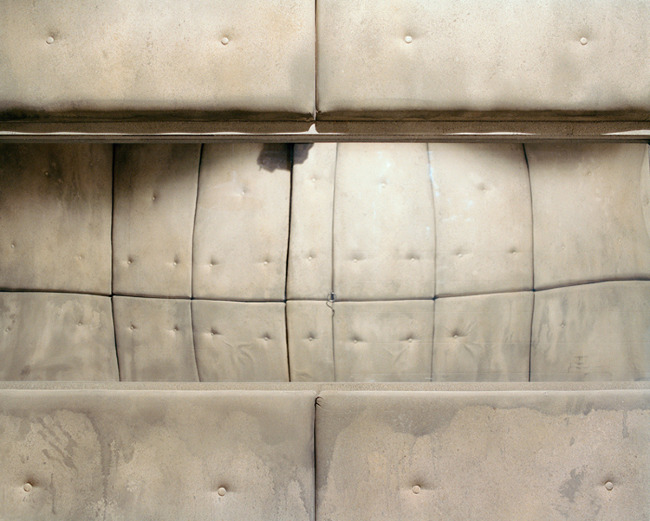
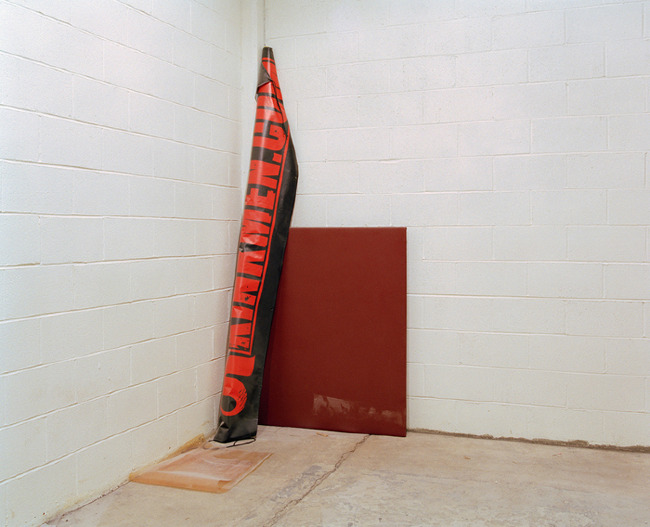
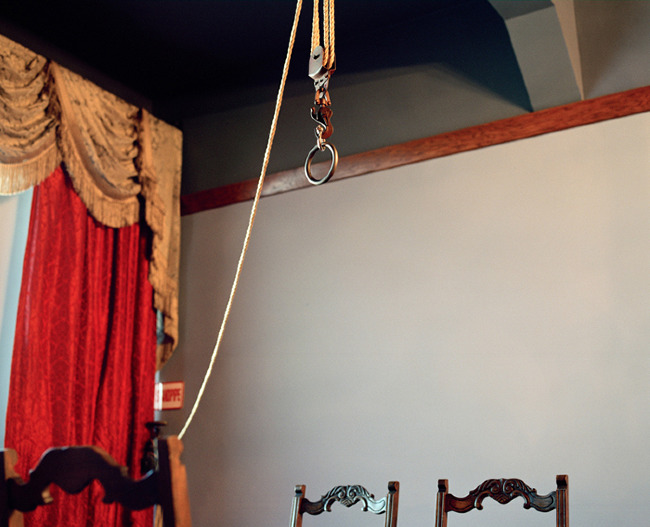
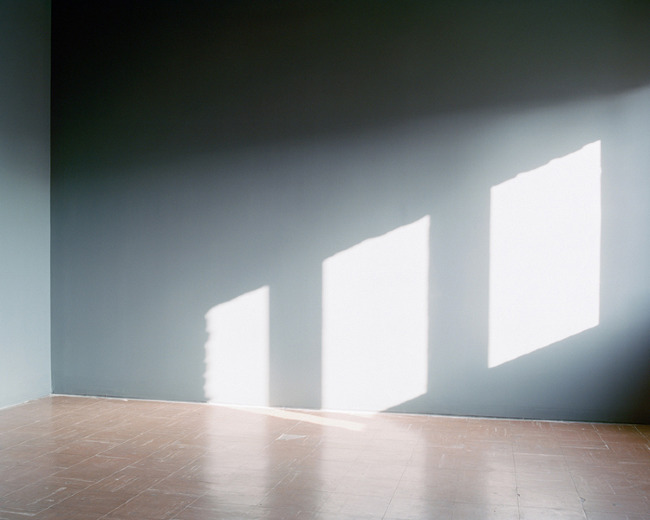
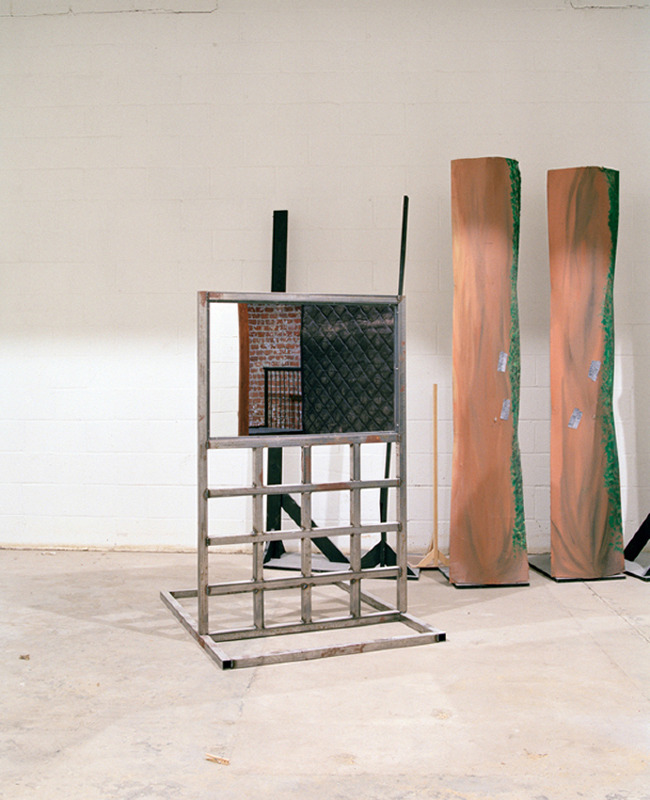
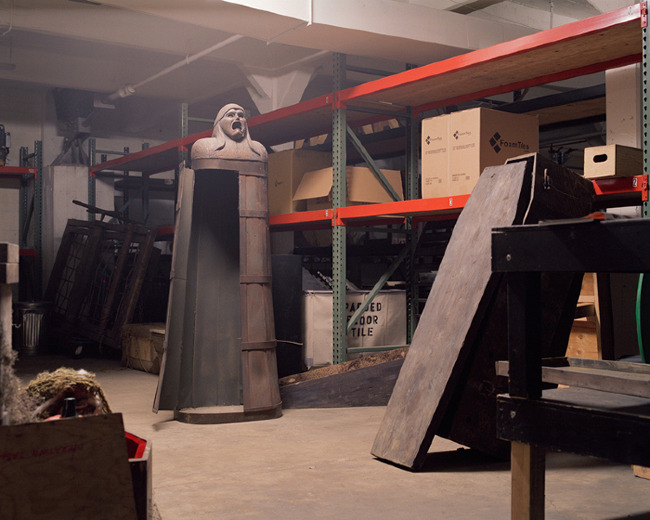
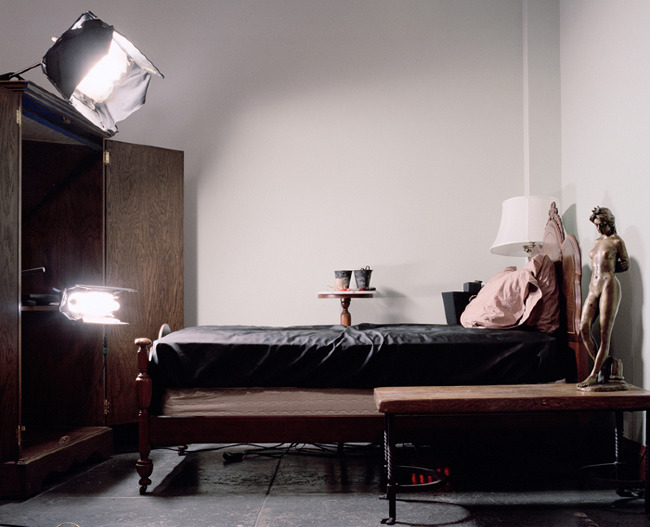
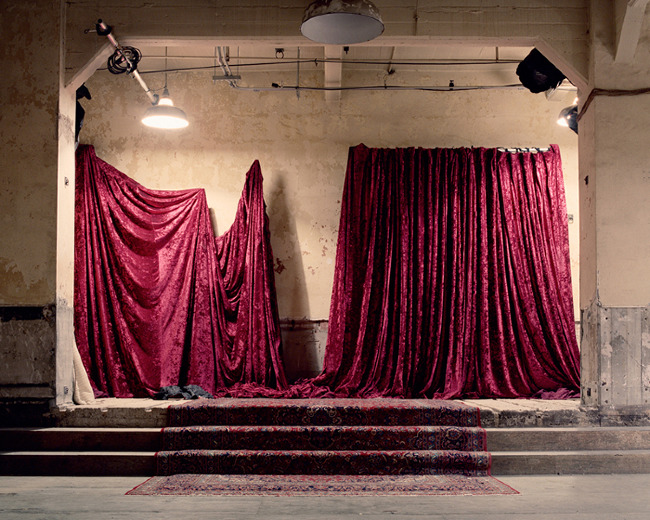
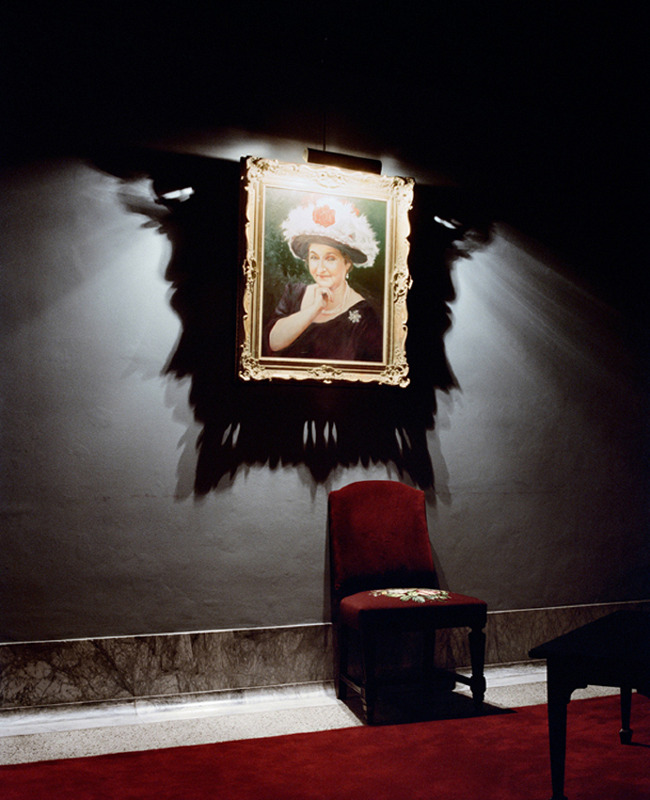 To view more of Elizabeth's work please visit her website.
To view more of Elizabeth's work please visit her website.


 WAN CHAI INSTAX LOVE: 999 By Rraay Lai
Changing, the rapid development of the old and the new landscape, what can leave?
Instant photography immediately presents your love and it become landscapes. It is a renegade the plan of time and project of public space.
Everything instant changed into the history.
Nine Nine Nine, in addition to emergency calls, it also means a long long time, the symbolic eternal meaning.
WAN CHAI INSTAX LOVE: 999 By Rraay Lai
Changing, the rapid development of the old and the new landscape, what can leave?
Instant photography immediately presents your love and it become landscapes. It is a renegade the plan of time and project of public space.
Everything instant changed into the history.
Nine Nine Nine, in addition to emergency calls, it also means a long long time, the symbolic eternal meaning.


 The renegade then willing to quickly growth of the city eternal regeneration and prosperous. Photographer during the exhibition will surprise wandering around in the exhibition, people and objects encounter may also become part of the landscape. Any Wanchai, people can take a picture since one will give participants an immediate becomes the works of the exhibition.
Police Station's WAN CHAI INSTAX LOVE: 999 Wanchai, re-imagine the variety of public space to reflect on their own relationship with the city.
Now is time to output powerful love. Love your……
The renegade then willing to quickly growth of the city eternal regeneration and prosperous. Photographer during the exhibition will surprise wandering around in the exhibition, people and objects encounter may also become part of the landscape. Any Wanchai, people can take a picture since one will give participants an immediate becomes the works of the exhibition.
Police Station's WAN CHAI INSTAX LOVE: 999 Wanchai, re-imagine the variety of public space to reflect on their own relationship with the city.
Now is time to output powerful love. Love your……









 Check out more of Rraay Lai's work on his website.
Check out more of Rraay Lai's work on his website.


 "We pass through the present blindfolded. We are permitted merely to sense and guess at what we are actually experiencing. Only later when the cloth is lifted, can we glance at the past and find out what we have experienced and what meaning it has." - Milan Kundera
Several years ago, I was diagnosed with Essential Tremor, a progressive neurological disorder which can cause debilitating tremors and loss of coordination, when the symptoms that I have had since adolescence eventually worsened to the point that I began experiencing difficulty in performing simple everyday tasks.
"We pass through the present blindfolded. We are permitted merely to sense and guess at what we are actually experiencing. Only later when the cloth is lifted, can we glance at the past and find out what we have experienced and what meaning it has." - Milan Kundera
Several years ago, I was diagnosed with Essential Tremor, a progressive neurological disorder which can cause debilitating tremors and loss of coordination, when the symptoms that I have had since adolescence eventually worsened to the point that I began experiencing difficulty in performing simple everyday tasks.

 The series, "And I" is a diary; a collection of glances which illustrate a reality distorted by frustration, embarrassment, and a growing sense of social isolation. It serves as a visualization of the impact that Essential Tremor has on me and my closest relationships as I continue to come to terms with the new realities that I am presented with.
The series, "And I" is a diary; a collection of glances which illustrate a reality distorted by frustration, embarrassment, and a growing sense of social isolation. It serves as a visualization of the impact that Essential Tremor has on me and my closest relationships as I continue to come to terms with the new realities that I am presented with.






 View more of George Holroyd's work on his website.
View more of George Holroyd's work on his website.


 To view more of Dustin's work please visit his website.
To view more of Dustin's work please visit his website.
 #1, Nude Studies, 2010
#1, Nude Studies, 2010 #2, Nude Studies, 2010
#2, Nude Studies, 2010 #3, Nude Studies, 2010
#3, Nude Studies, 2010 #4, Nude Studies, 2010
#4, Nude Studies, 2010 #5, Nude Studies, 2010
#5, Nude Studies, 2010 #1, The Kelly Pages, 2010
#1, The Kelly Pages, 2010 #2, The Kelly Pages, 2010
#2, The Kelly Pages, 2010 #3, The Kelly Pages, 2010
#3, The Kelly Pages, 2010 #4, The Kelly Pages, 2010
#4, The Kelly Pages, 2010 #5, The Kelly Pages, 2010
#5, The Kelly Pages, 2010 #6, The Kelly Pages, 2010
#6, The Kelly Pages, 2010 #7, The Kelly Pages, 2010
#7, The Kelly Pages, 2010 #8, The Kelly Pages, 2010
Fleur van Dodewaard’s recent solo exhibitions include The Celebration of the Monochrome, Proekt Fabrika, Moscow (2011) and Sun Set Series at Artpocalypse gallery, Amsterdam (2011). Group exhibitions include There’s Something Happening Here, Brancolini Grimaldi Gallery, London (2012), Brush it In at Flowers Gallery, London (2012) and STILL/LIFE, FOAM Photography Museum, Amsterdam (2011); Fleur is a recipient of several grants from the Dutch Foundation of the Arts Mondriaan Fund. Her work has been published in amongst others British Journal of Photography, HotShoe International and Foam Talent Magazine. Her work is part of the Museum of Modern Art Arnhem and of FOAM Photography Museum collections as well as numerous private collections.
For more work, visit her website.
#8, The Kelly Pages, 2010
Fleur van Dodewaard’s recent solo exhibitions include The Celebration of the Monochrome, Proekt Fabrika, Moscow (2011) and Sun Set Series at Artpocalypse gallery, Amsterdam (2011). Group exhibitions include There’s Something Happening Here, Brancolini Grimaldi Gallery, London (2012), Brush it In at Flowers Gallery, London (2012) and STILL/LIFE, FOAM Photography Museum, Amsterdam (2011); Fleur is a recipient of several grants from the Dutch Foundation of the Arts Mondriaan Fund. Her work has been published in amongst others British Journal of Photography, HotShoe International and Foam Talent Magazine. Her work is part of the Museum of Modern Art Arnhem and of FOAM Photography Museum collections as well as numerous private collections.
For more work, visit her website.

















 You can find more of her work on her website.
You can find more of her work on her website.

 Some(W)here
Some(w)here is a book about a journey in the most concrete and abstract sense of the word. The images were made over a 10 year period and traverse as many countries - Norway, Tajikistan, Mexico, China, Namibia - interwoven to guide the reader through a collage of vivid, yet intangible moments. Delicately designed by the Dutch designer Sybren Kuiper, Some(w)here meanders through this language of place to evoke the perceptual, emotional experience of memory and dream.
Some(W)here
Some(w)here is a book about a journey in the most concrete and abstract sense of the word. The images were made over a 10 year period and traverse as many countries - Norway, Tajikistan, Mexico, China, Namibia - interwoven to guide the reader through a collage of vivid, yet intangible moments. Delicately designed by the Dutch designer Sybren Kuiper, Some(w)here meanders through this language of place to evoke the perceptual, emotional experience of memory and dream.












 Some(W)here
Some(W)here










 Interested in seeing more of Andres work or even purchase a copy of Some(w)here please visit his website.
Interested in seeing more of Andres work or even purchase a copy of Some(w)here please visit his website.
 Raised up in a bi-cultural family with a Japanese mother and Swiss father, Favrod constantly searches for his identity in his works. His project Caijin - meaning "the foreigner" in Japanese - is intrigued by his experience of being rejected to obtain double nationality by the Japanese Embassy when he was 18. Caijin is a fictional narrative, a tool for his quest for identity, where self-portraits imply an intimate and solitary relationship that he has with himself. The mirror image is frozen in a figurative alter ego that serves as an anchor point. The aim of this project is to create “his own Japan” in Switzerland, from memories of his journeys when he was small, his mother’s stories, popular and traditional culture and his grandparents’ war narratives.
Tell us about yourself and how you become interested in photography.
My name is David Favrod. I was born on the 2nd of July 1982 in Kobe, Japan, of a Japanese mother and a Swiss father. After business school, I decided to change my path by attending an art school learning industrial design (Ecole cantonal d'art de Lausanne,ECAL)). This is where I discovered photography. We had one photography course every week. After the first half of the year, I decided to turn to photography. Now I’ve been taking pictures for 7 years.
How do you like living in Switzerland?
Switzerland is a really great place for an artist. Good artists, good schools, good museums and galleries.
Raised up in a bi-cultural family with a Japanese mother and Swiss father, Favrod constantly searches for his identity in his works. His project Caijin - meaning "the foreigner" in Japanese - is intrigued by his experience of being rejected to obtain double nationality by the Japanese Embassy when he was 18. Caijin is a fictional narrative, a tool for his quest for identity, where self-portraits imply an intimate and solitary relationship that he has with himself. The mirror image is frozen in a figurative alter ego that serves as an anchor point. The aim of this project is to create “his own Japan” in Switzerland, from memories of his journeys when he was small, his mother’s stories, popular and traditional culture and his grandparents’ war narratives.
Tell us about yourself and how you become interested in photography.
My name is David Favrod. I was born on the 2nd of July 1982 in Kobe, Japan, of a Japanese mother and a Swiss father. After business school, I decided to change my path by attending an art school learning industrial design (Ecole cantonal d'art de Lausanne,ECAL)). This is where I discovered photography. We had one photography course every week. After the first half of the year, I decided to turn to photography. Now I’ve been taking pictures for 7 years.
How do you like living in Switzerland?
Switzerland is a really great place for an artist. Good artists, good schools, good museums and galleries.

 What interests and inspires your art?
Books, films, history, memories, fairy tales and my family.
You are raised in a very interesting family with a Swiss father and Japanese mother. How does Swiss and Japanese culture influence your works?
My bi-cultural education is the essence of my inspiration. The majority of my inspiration comes from things that are around and within me. I do not think I could tell you how each culture has influenced my work. Rather it's the mix of these two cultures that influence it.
Gaijin creates your own Japan in Switzerland. Can you tell us more about your art making process?
Gaijin is a project that I began in 2009. I started it as my bachelor degree’s project at the Ecole Cantonale d’Art de Lausanne and afterward I extended the series. This first approach is to bring together various topics that are important to me, for example, the war stories of my grandparents, the correlation between Switzerland and Japan, the family archives, the stories that my mother told me when I was little, or the mountains. Gaijin is a fictional recital, a tool for my quest for identity, where auto-portraits imply an intimate and solitary relationship that I have with myself. The mirror image is frozen in a figurative alter ego that serves as an anchor point.
What interests and inspires your art?
Books, films, history, memories, fairy tales and my family.
You are raised in a very interesting family with a Swiss father and Japanese mother. How does Swiss and Japanese culture influence your works?
My bi-cultural education is the essence of my inspiration. The majority of my inspiration comes from things that are around and within me. I do not think I could tell you how each culture has influenced my work. Rather it's the mix of these two cultures that influence it.
Gaijin creates your own Japan in Switzerland. Can you tell us more about your art making process?
Gaijin is a project that I began in 2009. I started it as my bachelor degree’s project at the Ecole Cantonale d’Art de Lausanne and afterward I extended the series. This first approach is to bring together various topics that are important to me, for example, the war stories of my grandparents, the correlation between Switzerland and Japan, the family archives, the stories that my mother told me when I was little, or the mountains. Gaijin is a fictional recital, a tool for my quest for identity, where auto-portraits imply an intimate and solitary relationship that I have with myself. The mirror image is frozen in a figurative alter ego that serves as an anchor point.


 After Gaijin, in 2010, I produced the book Omoide Poroporo, which was published at Kodoji Press. It is a mix of my pictures and archives of and from my family, and now I am producing a series called HIKARI, a work about the memories of my grand parents during the war.
Each of your images seems to have a lot of stories behind it. Do you want to talk about some of them?
Shadako, the image of the window with the paper birds, is about the woman Sadako who at her home close to Ground Zero when the atom bomb was dropped in Hiroshima in 1945. Years later, she developed leukemia and was hospitalized in 1955 and given a year to live. She died in 1955 at the age of 12.
During a hospital visit, Sadako’s best friend folds an origami crane as an old Japanese story says that who folds 1,000 origami cranes will be granted a wish by a crane. As Sadako didn’t manage to fold all 1,000 cranes, her friends folded the remaining ones and buried them with her. With this image, I want to speak about the war, the memory and the atomic bomb.
Mishiko is about the sister of my grandfather. She fell ill during the Second World War, doctors diagnosed her a poor hydration. In Japan, watermelon is a very popular fruit that holds a lot of water. So his parents gave her watermelon regularly. But the diagnosis was wrong and it was a salt deficiency and she died shortly after.
After Gaijin, in 2010, I produced the book Omoide Poroporo, which was published at Kodoji Press. It is a mix of my pictures and archives of and from my family, and now I am producing a series called HIKARI, a work about the memories of my grand parents during the war.
Each of your images seems to have a lot of stories behind it. Do you want to talk about some of them?
Shadako, the image of the window with the paper birds, is about the woman Sadako who at her home close to Ground Zero when the atom bomb was dropped in Hiroshima in 1945. Years later, she developed leukemia and was hospitalized in 1955 and given a year to live. She died in 1955 at the age of 12.
During a hospital visit, Sadako’s best friend folds an origami crane as an old Japanese story says that who folds 1,000 origami cranes will be granted a wish by a crane. As Sadako didn’t manage to fold all 1,000 cranes, her friends folded the remaining ones and buried them with her. With this image, I want to speak about the war, the memory and the atomic bomb.
Mishiko is about the sister of my grandfather. She fell ill during the Second World War, doctors diagnosed her a poor hydration. In Japan, watermelon is a very popular fruit that holds a lot of water. So his parents gave her watermelon regularly. But the diagnosis was wrong and it was a salt deficiency and she died shortly after.








 Your exhibition view is quite unique with your works printed in various sizes. What’s your thought behind that?
Each picture has its own size. Each series has its own presentation—framed or not, oak frames or black frames, difference papers to use…Then I deal with the different images that I want to show. I think about the rhythm, the sequence of images, and the relationship between them: in opposition or related by meanings.
You have an amazing exhibition list both in Europe and America. Could you give our readers some advise on how to get works out there?
Just be persevering, loving what you do and sharing your work.
David Favrod website
Interview by Zhenjie Dong. Zhenjie is a Chinese born and New York based artist and photographer exploring ways to express her social and political concerns through photography. She spoke at TEDxCreative Coast 2012 about her work Recreating Myth and the philosophy behind it. Her works have been exhibited in the Atlanta Photography Group Gallery, the North Carolina Museum of Art, and will join the global tour of the Lumen Prize Exhibition, travelling around the world in United Kingdom, Latvia, China and Wales.
Your exhibition view is quite unique with your works printed in various sizes. What’s your thought behind that?
Each picture has its own size. Each series has its own presentation—framed or not, oak frames or black frames, difference papers to use…Then I deal with the different images that I want to show. I think about the rhythm, the sequence of images, and the relationship between them: in opposition or related by meanings.
You have an amazing exhibition list both in Europe and America. Could you give our readers some advise on how to get works out there?
Just be persevering, loving what you do and sharing your work.
David Favrod website
Interview by Zhenjie Dong. Zhenjie is a Chinese born and New York based artist and photographer exploring ways to express her social and political concerns through photography. She spoke at TEDxCreative Coast 2012 about her work Recreating Myth and the philosophy behind it. Her works have been exhibited in the Atlanta Photography Group Gallery, the North Carolina Museum of Art, and will join the global tour of the Lumen Prize Exhibition, travelling around the world in United Kingdom, Latvia, China and Wales.
 Sway 2011
Sway 2011 We Tigers 2012
We Tigers 2012 Baby Bird 2011
Chosen Blood
My current body of work, Chosen Blood is an ongoing exploration that brings to light familial aspects
of the human experience and the intricate ties formed with others; the bonds between blood and chosen blood. This project explores the intimacy and truths of the body and spirit; innate and extrinsic attractions and behaviors. The closeness of this family is rare. My photographs strive to celebrate this closeness, their wildness, their innocence, their energy, their vulnerability.
Baby Bird 2011
Chosen Blood
My current body of work, Chosen Blood is an ongoing exploration that brings to light familial aspects
of the human experience and the intricate ties formed with others; the bonds between blood and chosen blood. This project explores the intimacy and truths of the body and spirit; innate and extrinsic attractions and behaviors. The closeness of this family is rare. My photographs strive to celebrate this closeness, their wildness, their innocence, their energy, their vulnerability.
 Jessi Peeing 2011
Jessi Peeing 2011 The Rescue 2011
The Rescue 2011 Spirit 2011
Spirit 2011 Untitled (Kitchen) 2011
Untitled (Kitchen) 2011 Blood Heart 2012
Blood Heart 2012 Icarus 2012
Icarus 2012 Oh Captain 2012
Oh Captain 2012 The Reward 2012
The Reward 2012 The Pull 2012
The Pull 2012 Pie 2012
Pie 2012 Swing 2011
To view more of Katie's work please visit her website.
Swing 2011
To view more of Katie's work please visit her website.

 The Middle Kindgom
Uncertainty exists in the corners of rural college towns, it can be found in the landscape, it raises its head in the suburbs and sheltered communities across the United States. Occupying the space between innocence and experience, here uncertainty thrives. This work seeks out those coming into adulthood, met with the effects of collapsing emotional, economic, and physical systems of support of what was promised and what is.
The Middle Kindgom
Uncertainty exists in the corners of rural college towns, it can be found in the landscape, it raises its head in the suburbs and sheltered communities across the United States. Occupying the space between innocence and experience, here uncertainty thrives. This work seeks out those coming into adulthood, met with the effects of collapsing emotional, economic, and physical systems of support of what was promised and what is.









 For more work, please visit her website
For more work, please visit her website